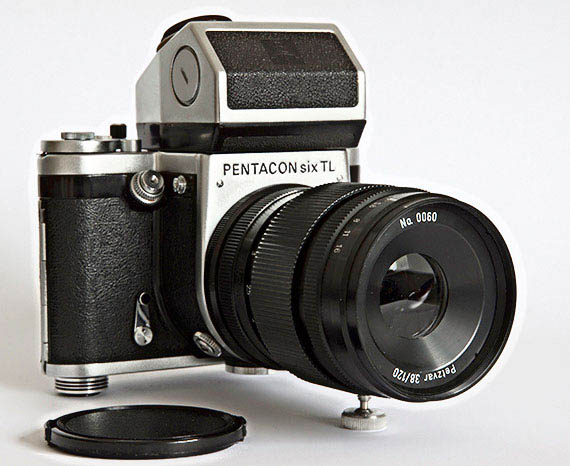
[petz_p6.jpg]
The Pentacon Six System
Lens Data Summary
120mm
Petzvar Portrait Lens

[petz_p6.jpg]
In the year 2014, a totally new lens in the Pentacon Six mount was manufactured. This was the 120mm f/3.8 Petzvar Portrait lens designed and produced by Dennis Ivanichek. He describes it as “a fine art lens”. This means that it has special characteristics, which I will describe later.
The history
Ivanicheck states: “I'm
pretty sure you have heard about the Petzval design lenses
before. Briefly, it is the first mathematically calculated
lens scheme, that improved the speed of the portrait lenses.
In 1840, Joseph Petzval, a Professor of Mathematics at
Vienna University, came up with a lens design that provided
for speeds of f/3.6, which was many times faster, than all
existing lens designs available at that period.”
Writing in 2013,
Ivanichek stated, “I crafted my first Petzvar over
three years ago. It was crude and lacked an
aperture, but it worked and produced very
artistic images. After my
first success, I've decided to invest in
making a proper lens body. I
have a strong engineering background,
therefore it wasn't difficult for me to
create a technical drawings of the lens body
components. With a help
of the Diamond Technologies Inc. machine
shop, equipped with sophisticated precision
CNC machines, my drawings turned into a
solid lens housing.” Ivanichek designed
the lens to work on 6×6 medium format cameras,
and chose to use the Pentacon Six mount in
order to be able to use the lens on cameras
with this mount and also via adapters on 35mm
full-frame cameras. In
response to requests, he also agreed to make
some lenses with the Hasselblad “V” series
mount for 2000 series Hasselblads, which have
a focal plane shutter.
Image to the right: Petzvar
on Kiev 88CM (Pentacon Six mount).
To the right of it, Petzvar on
Hasselblad 2000F (with Kiev TTL/Spot prism!)
Picture courtesy of Dennis Ivanichek

What one man can achieve
To make the project financially viable, Ivanichek concluded that he would have to order the manufacture of components for 100 lenses, and in an attempt to fund this, he set up a Kickstarter project.
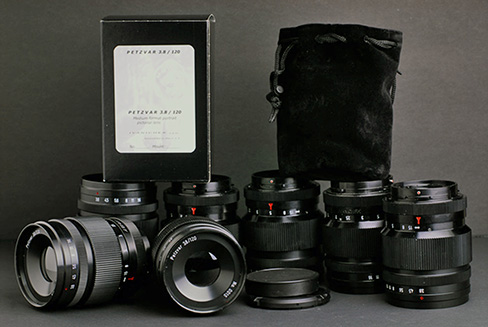 Petzvars with Pentacon Six mount, ready
for dispatch
Photo courtesy of Dennis
Ivanichek
|
The details are here: https://www.kickstarter.com/projects/1162663202/the-petzvar-f-38-120-mm-medium-format-petzval-port
Within a month, he had enough pledges of support to proceed with the project! In the course of 2014 he ordered and received the lens elements, barrel components and camera mount, but he himself engraved the name plates, the distance scales on the barrel and the aperture numbers on the aperture control rings, using a Scripta SM pantograph engraving machine, and he assembled the components. Those who are interested to see in detail some of the challenges and delays involved in such a project will find the Updates reports on the Kickstarter pages interesting. |
Specification
(Taken from Ivanichek's description on Kickstarter)
|
|
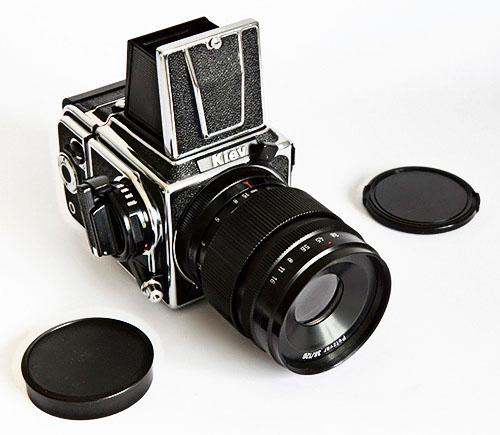 The Petzvar mounted on a Kiev
88CM
with front and rear caps shown on
each side of lens
[petz88cm.jpg] |
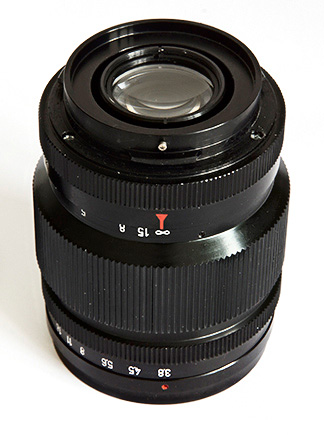 Rear view of the Petzvar in the Pentacon Six mount [petzback.jpg] |
Mechanical description
| The
Petzvar is a three-element lens. The glass
elements are (unfortunately!) uncoated. The lens has a 10-blade iris aperture, which Ivanichek explains is more round than an aperture with only six blades.
|
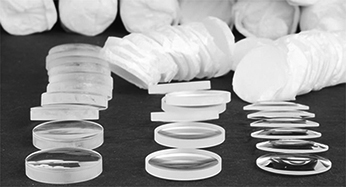 Elements as received from the
manufacturer
|
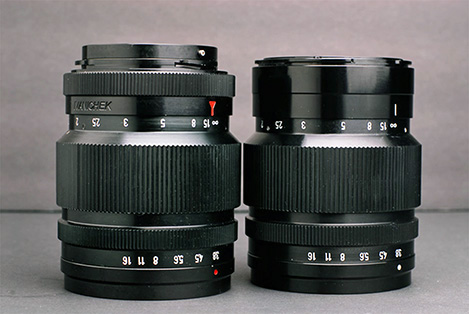 The two different camera mounts
On the left: Pentacon Six mount, on the
right, Hasselblad "V"
Image: Dennis Ivanichek |
The engravings on the lens name ring and for the aperture and focussing scale are filled with white paint. Distances are marked in meters. The index dot for the aperture and the arrow/triangle for the focussing distance are filled with red paint. (On the Hasselblad version, as far as I can see from the photographs in Kickstarter and on Ivanichek’s website, the focussing index mark is a straight white line and the aperture index dot is white, but – as is normal with lenses for the Hasselblad – the triangle on the back of the lens mount that shows how to align the lens when mounting it on the camera is in red.)
Note that there is no pin for automatic aperture stop down and no pre-set stop-down mechanism. However, for the intended use – portraiture – the absence of these features should not be a problem. |
| The Petzvar
lens was supplied with front and rear caps and
a soft lens pouch in a very smart, glossy
retail box.
The front cap is a spring-loaded
centre-pinch plastic cap, chosen by Ivanichek
instead of a metal screw-in cap, which he
considers would scratch the filter
thread. The rear lens cap seems to be
the standard Arsenal back cap that was
supplied on lenses that have the Kiev 60
(Pentacon Six) mount. |
Comparison
with other lenses of similar focal length: 150mm
portrait lenses
|
How does the
Ivanichek Petzvar compare with other lenses of similar
focal length that are available in the Pentacon Six
mount? The most obvious, relatively
commonly-available lenses of similar focal length and
suitable for some sorts of portraiture are the 150mm
Arsenal Kaleinar and the 150 mm Schneider-Kreuznach
Tele-Xenar for the Exakta 66 of 1984-2000.
At this point I will compare
merely the physical characteristics: size, weight,
specifications and quality of finish.
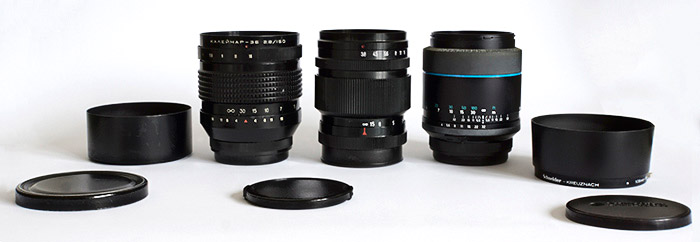 The Kaleinar, the Petzvar and the 150mm Tele-Xenar are of similar dimensions [pz150_02.jpg] |
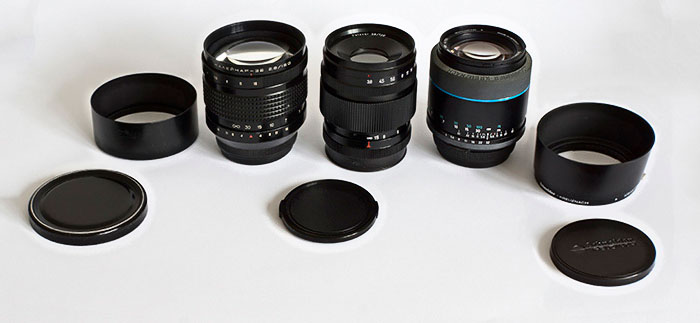 From left to right: Arsenal Kaleinar, Ivanichek Petzvar, Schneider-Kreuznach Tele-Xenar Lens hoods (shades) were bought separately for the Kaleinar and the Tele-Xenar [pz150_01.jpg] |
Comparison
with other 120mm lenses
|
There are of
course two other 120mm lenses in the Pentacon Six/Kiev
60 mount: the 120mm Carl Zeiss Jena Biometar and the
120mm Arsenal Vega-28B lens. Neither of these
lenses is common, but nor can they be described as
"rare". Both are reviewed elsewhere on this
website. The Vega has the unusual characteristic
of being very short for the focal length in question.
Here are the key specifications
of these lenses.
 Here, each lens has a different back cap, which changes the apparent height of the lens, especially in the case of the Vega-26B. [pz120_02.jpg] |
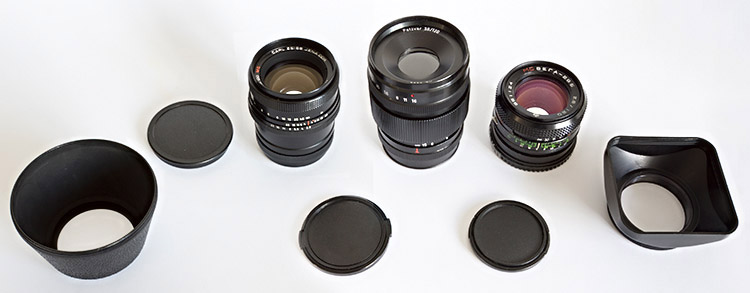 Three 120mm lenses, from left to right: Carl Zeiss Jena Biometar, Ivanichek Petzvar, Arsenal Vega-26B Again, lens hoods (shades) were bought separately for the Zeiss and Arsenal lenses [pz120_01.jpg] With both of these comparisons, it
is clear that the Petzvar has a much closer minimum
focussing distance than any of the other four lenses
shown here, although this is a feature that is not
likely to be important for portraiture. However,
Ivanichek does show a sample close-up picture of berries
taken with the Petzvar. Its use need not be
limited to portraiture.
|
To judge from the lens that I have received, Ivanichek has been very successful in the design, manufacture and assembly of these lenses.
|
|
He writes, “I have used modern
synthetic grease for helicoid lubrication to avoid
creeping of the grease and evaporation of it, that
creates condensation of the grease particles
(fogging) on the glass elements.”
The aperture ring engages with (hidden) détentes at each full aperture setting, the first détente, which is for the half-stop at f/4.5, being less deep than the others. I have so far mounted this lens on a Pentacon Six and a Kiev 88CM, and in both cases it fitted the camera mount perfectly. |
Ivanichek states:
“Unfortunately, I do not have
access to sterile premises for lens assembling, therefore,
occasional small dust particles are unavoidable inside. But
those definitely won't cause any problems.
Especially considering rather soft image of the lens due to
its chromatic aberrations, compared to modern, better
corrected lenses.”
In the lens that I have, no dust is visible to the naked
eye.
How successful is this lens?
For medium format, the normal focal lengths for a portrait lens are considered to be between 150 and 250mm. In the Pentacon Six mount there are various lenses in this range, including the fabulous Carl Zeiss Jena 180mm Sonnar.
It seems to me that in going for the slightly shorter 120mm,
Ivanichek has wanted to design a lens that would also be
very useful also for portraits with full-frame 35mm cameras,
whether analogue or digital.
Images by Ivanichek, and others that are beginning
to appear on the web, demonstrate that even in 6×6 format,
this lens can produce excellent portrait compositions.
Who
is the man behind this lens?
On
his website http://ivanichek.com/About_us.htm
, he says:
My name is Dennis Ivanichek. I am a
photographer and analogue photography enthusiast. I was born in
Chelyabinsk (Russia). In 1995 I graduated from the Railroad
Transportation College in Chernivtsy (Ukraine) with a Diploma in
Electromechanical engineering.
Since 2004 I live in ... USA.
I'm running a small online business specializing in service and
repair of a classic medium and large format cameras such as
Rolleiflex and Graflex.
If You have any questions or comments, please feel free to e-mail
me:
dennis@ivanichek.com
What sort of image does this lens produce?
|
Ivanichek says, “In our age of
technologies and flawless images taken with digital
cameras, anything which delivers a not-so-perfect image
draws the attention of creative photographers. On his own website (http://www.ivanichek.com/Medium%20format%20Petzvar%20Petzval%20lens.htm ), he states: “The Petzvar 120 mm f= 1:3.8
portrait lens is not a re-designed or improved model, it
is a genuine Petzval with all of its inherent flaws and
imperfections.
|
 |
Bokeh
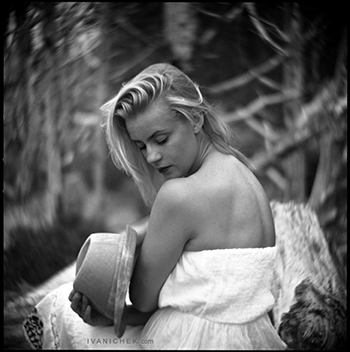 Image courtesy of Dennis
Ivanichek
|
One of the important requirements of a portrait lens is its ability to put background and unessential foreground features out of focus. This is extremely difficult with most modern digital cameras, and impossible with many of them, as the small sensor and short focal length result in everything being in focus – no doubt ideal for untrained snapshotters, but undesirable for anyone aspiring to produce images with more artistic control and expression. This ability is probably what Ivanichek had in mind when he described his Petzvar as “a fine art lens”. Whether you like or dislike
the swirly bokeh is a question of personal taste. The
lens clearly needs to be tested at a range of
apertures and with the background of varying types and
at varying distances from the main subject, to
determine how these changes affect the bokeh.
The mere production of this lens in 2014 in the Pentacon Six mount does reinforce what this website has been saying for more than twelve years: that the Pentacon Six camera is a camera that can produce images of professional standard and that it is a significant model on a world-wide scale. Other cameras with the P6 mount also benefit from using this mount.
|
Test
Results
To see some results from the
Ivanichek Petzvar lens that I have (which is the one that is
illustrated at the top of this page and in most of the other
images on this page), click here.
To go back to the beginning of the Lens
Data section, click below and then choose the range of lenses
that you want to read about.
© TRA March 2015, revised August 2015